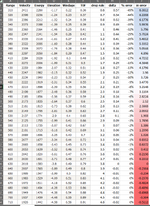- Thread Starter
- #81
solarshooter
Lil-Rokslider
I do get that if we want to stay in angles we can stay in angles. The intuition for length on target was just that, and only applies should you ever want to translate length on target to angle. I really do want to know more about the inherent benefits of mils. I've learned alot in this thread as a result.True. When I read this line of his post below:
I thought "he doesn't get it". And then I read the rest of it and got the impression he doesn't want to get it.

